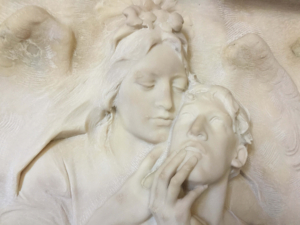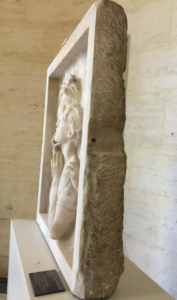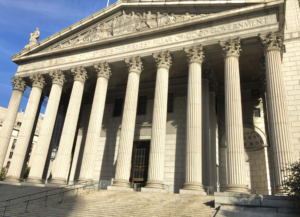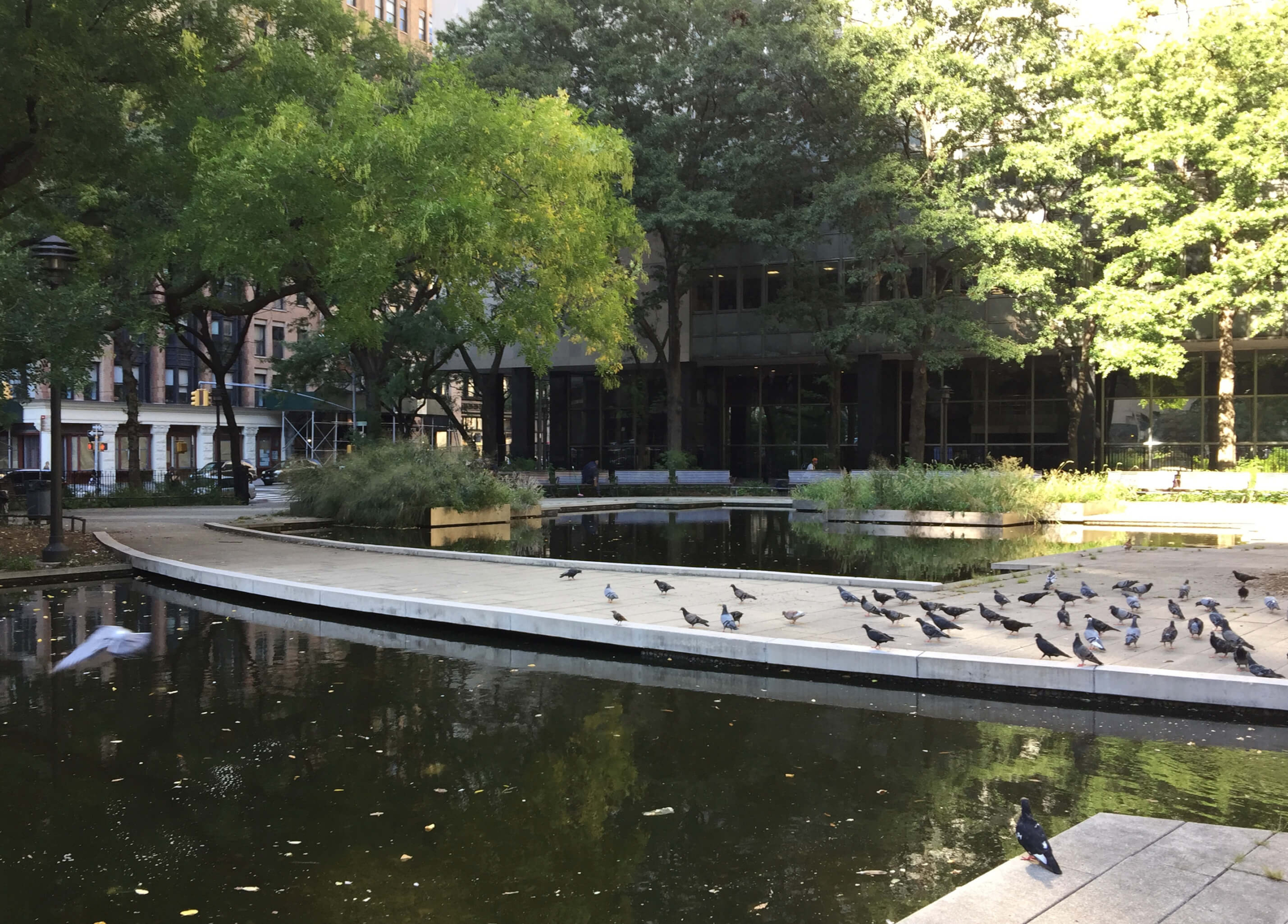E. The Foster Family and a Home for the Marble Relief

When the marble relief was delivered to the 60 Centre Street courthouse upon the completion of the Metropolitan Museum’s conservation work, it was covered in cloth and placed upright on a wooden dolly. The dolly was consigned, for what was intended to be a modest period, to a storage area off the Courthouse’s grand rotunda in one of 60 Centre Street’s converted elevator shafts. No action was taken to follow up on the Art Commission’s requirement that a frame be reviewed by a committee. The relief presented a serious challenge for the court as, lacking a stand or frame, it could not be safely and respectfully exhibited. Significant intervention was required to remedy the situation, but there were no funds on hand at the courthouse to pay for what it would take to do so and little experience on the part of the court with the displaying of heavy art objects. The surviving piece of the tribute to Mrs. Foster thus remained where it had been placed for almost the next 30 years, amidst podiums, sound speakers, maintenance equipment, and such pedestrian fare.
The Foster family had certainly never forgotten about Mrs. Foster and the memorial. One of Mrs. Foster’s sisters, Lila Elizabeth Elliott (Mrs. Charles R. Duff), for instance, had assembled (circa 1904) a formidable scrapbook of newspaper clippings about her sister and her work. Lila’s granddaughter, thus Mrs. Foster’s grandniece, Jeremy Ann Brown, had been fascinated as a child by the contents of the scrapbook, which eventually came into her custody, and by the story of her great aunt reflected in that scrapbook.
By the early 2000’s, Ms. Brown was wondering what had ever happened to the monument and undertook some informal investigations to try to discover its fate and where it might be located if it had survived.
Jeremy had been the victim of an attack by an individual who had been paroled from the Pennsylvania prison system. (It is a sad irony indeed that such a thing should have happened to a relative of a woman who, a century before, had so devoted herself to helping and rehabilitating detainees of the original Tombs prison.)[275] Subsequently, Governor George Pataki appointed Jeremy to the New York State Commission on Judicial Conduct, which weighs complaints against judges. While on the Commission, she asked Gerald Stern, Esq., then-Administrator of the Commission on Judicial Conduct, and Robert Tembeckjian, Esq., then-Clerk or Counsel to the Commission, whom she might approach to inquire about what had become of the tribute to her great aunt. Stern and Tembeckjian referred her to the Honorable Norman Goodman, the long-serving County Clerk of New York County, since they knew that he had familiarity with the courts in Manhattan. Stern, Tembeckjian, and Jeremy were entirely unaware at this time where the monument might be. Jeremy contacted Mr. Goodman and met with him in his office at the New York County Courthouse in or about 2006. A representative of the Public Design Commission was also in attendance. It was Mr. Goodman who informed Jeremy that only a portion of the original monument was in existence, i.e., the marble relief by Karl Bitter, and that the surviving portion was in storage in the very building in which they were meeting, 60 Centre Street.

John Werner, who had been employed at 60 Centre Street since 1970 and who became the Chief Clerk of the Supreme Court, Civil Branch in 1989, was at some point informed that the Bitter relief was at 60 Centre Street in storage, but he was not advised of the history of the monument to Mrs. Foster, nor the work and the life that it had been created to honor. One day in or about 2008, more than 100 years after the Foster Memorial had first been unveiled, Mr. Werner paid a visit to the office of Mr. Goodman, and chanced upon a meeting that was underway the subject of which was the monument to Mrs. Foster. Included among the group present were representatives of the Department of Citywide Administrative Services, the Municipal Art Society, and the Public Design Commission, and a person Mr. Werner understood to be a grandniece of Mrs. Foster. Mr. Werner had not been invited to the meeting, but the subject was of interest to him, so he simply joined the meeting, an action with which he knew that Mr. Goodman would be comfortable. At the conclusion of the meeting, the group toured the rotunda and the entrance lobby of the courthouse and the consensus of the group was that, if the tribute could be restored to public view, it should be placed in a niche in the entrance lobby on the right-hand side, one of the sites recommended, unbeknownst to the group, so many years before. Of course, these difficult questions remained: How could the relief be displayed safely, effectively, and in a manner that would be artistically appropriate? How could a frame or support be created (which obviously is not a subject with which a court normally deals)? And how would the display be paid for?
Mr. Werner made no notes at the meeting inasmuch as he had just happened by. All who attended that meeting went their separate ways to address the many tasks facing them. There was no further discussion for years thereafter of restoring the tribute to Mrs. Foster to public view. In April of 2014, Mr. Werner, wondering what had become of Mrs. Foster’s grandniece and her interest in the surviving portion of the monument to her great aunt, asked Mr. Goodman if he had the name of Mrs. Foster’s grandniece, which Mr. Werner did not recall (if he had ever been informed of it at the time of the meeting), and contact information for her. Mr. Goodman said he did not have any contact information, but he seemed to remember that her surname was “Brown.” Twenty or so years before, that would have been the end of the search, but Mr. Werner then googled “Brown” and “Tombs Angel” and a posting from some years earlier came up with an e-mail address for “Jeremy Brown.” Mr. Werner then sent an e-mail to that address inquiring whether any information was available about the relative of Mrs. Foster who had visited 60 Centre Street years before inquiring about the 1904 tribute. It had not occurred to Mr. Werner that “Jeremy Brown” might be a woman! Within the day, Mr. Werner received an e-mail reply from Jeremy, who identified herself as the person who had participated in the meeting in Mr. Goodman’s office in 2008. From the day of those e-mail exchanges onward, Jeremy Brown and Mr. Werner worked together in an effort to return the tribute to Mrs. Foster to public view at 60 Centre Street.

The effort to restore the Bitter relief to public view was a lengthy and complicated process. It was also, however, a collaborative process, among the Public Design Commission’s Keri Butler; the Municipal Art Society’s Phyllis Cohen; Lana Kim of the Department of Citywide Administrative Services (“DCAS”); Ottavino Stone Corp.’s Kate Ottavino; the Supreme Court, Civil Branch, New York County; and, of course, Jeremy Ann Brown on behalf of the Foster family. Substantial effort was put into investigating and considering the relative merits, including the practicality, of the options that might be available to display in a secure and appropriately dignified manner the large and very heavy carving. Eventually, it was decided that a stand that could accommodate the weight of the relief and that would be designed in such a way as not to distract the viewer’s attention from the artwork would be crafted by the Ottavino Stone Corporation. Ottavino would also perform some further restoration work funded by DCAS. The Municipal Art Society was able to obtain funding for the stand for the marble relief through a generous grant from the Porzelt Foundation.
The relief was moved from the courthouse to the Ottavino firm. The restoration work was conducted under the direction of conservator Kate Ottavino and consisted of cleaning the piece and replacing some of the fills/patches in cracks that had deteriorated with the passage of time.[276] The stand was built and delivered to the Supreme Court at 60 Centre Street in 2019. It was then installed in the niche in the vestibule that had been selected previously. The relief was returned to the courthouse and placed on the stand, a challenging process that, because of the great weight of the carving, involved the use of hoists and scaffolding.

Not long afterward, in June 2019, the relief was rededicated in a public ceremony in the beautiful and historic rotunda of the Supreme Court building at 60 Centre, a program that celebrated Mrs. Foster, her decades of work on behalf of the poor and imprisoned, and Karl Bitter, while expressing gratitude to the Public Design Commission, DCAS, the Municipal Art Society, and the Porzelt Foundation for the critical assistance they had provided. The installation and rededication of the long-lost relief were the subject of a number of articles in various publications,[277] including one on the first page of the “Arts” section of the New York Times that included a large and lovely photograph of the relief.[278] A very large crowd, standing room only, attended the ceremony. Jeremy Ann Brown, her grandmother’s scrapbook in hand, spoke at the event and members of her family were in attendance to witness, finally, after 115 years and such sad misfortune, the return to public view of the surviving portion of the monument. (Thanks to the generosity of Jeremy Brown and the Foster family, the scrapbook has now been donated to the archives of the Public Design Commission.) Two scholars gave presentations that provided important and interesting context. Professor Jon Ritter of New York University presented an appreciation of the marble relief and discussed Karl Bitter and his artistic importance.[279] Robert Pigott, Esq., an author with a scholarly interest in the history of New York City and its buildings, described, including through the use of period photographs, the original Tombs and its immediate successor, the courts of the period, and the surroundings in which Mrs. Foster went about her work.[280] Given Mrs. Foster’s long connection to the church and the central role it had played in her life, it was fitting that the current rector of Calvary Church, the Rev. Jacob Smith, and its archivist, Eric Stedfeld, were in attendance as well.[281]
Karl Bitter had the capacity, through his skill and the creativity of his designs, to infuse much emotional power into his sculpture. This is evident, for example, in his moving Villard Memorial in Sleepy Hollow, as well as in the Crane Tablet, which may have been inspired by the Foster carving.[282] Although unfortunately we cannot today feel the full impact of the Foster Memorial as it was when Bitter created it, the surviving portion exhibits that emotional power, especially when one knows the story of the Tombs Angel and why the carving depicts an angel helping a young person in trouble. As one writer at the time who knew Bitter wrote, “[t]here is much sentiment … in such a work as his tablet in recognition of the self-sacrificing life among the unfortunates and erring of Mrs. Rebecca Foster, ‘The Tombs Angel,’ for the Criminal Courts Building, New York.”[283]

It is said that timing is everything, and so it sometimes appears. During the two years or so before the rededication of the Foster memorial, the New York Times had run a series of articles and op-ed columns about the dearth of tributes in New York City and beyond to women deserving of recognition, in contrast with the countless monuments to deserving, and not so deserving, men.[284] Thus, the timing of the restoration to public view of the surviving portion of the Foster Memorial could not have been more appropriate. Here we have a marble relief, a work of art that is impressive on its own terms, from a very rare historical monument to a woman, one who, during an important and difficult period in New York City’s history, through her extraordinary energy and dedication and the power of her compassion, made great contributions to the City, the system of justice, the development of the values they hold dear, and the City’s inhabitants, especially prisoners, their families, immigrants and the poorest and most abandoned, and who, by her actions, offered a pathway, in many ways a visionary and groundbreaking one, by which society might reclaim to a decent and productive life those who have fallen afoul of its laws. Finally, after so much trouble, the surviving portion of the memorial to the Tombs Angel had found a permanent home. It can be hoped that, today and far into the future, many will view the surviving relief of the ministering angel and admire it for its beauty and the depth of feeling it conveys through the fine hand of Karl Bitter, will remember the life and work of the Tombs Angel, as had been the intention of all those who donated in 1902 to make the memorial possible, and will perhaps even be inspired to go forth and put into practice in their own ways the law of kindness by which Mrs. Foster lived.
Table of Contents
A. Introduction
B. The Life and Work of Rebecca Salome Foster
- The Backgrounds of Rebecca and John A. Foster
- New York City in the Late 19th Century
- How Mrs. Foster’s Work Began
- What Mrs. Foster Did for Prisoners, Their Families, the Courts, and Others
- Mrs. Foster’s Work in Her Own Words
- Funding the Work
- Providing Legal Assistance
- Traveling Throughout the City and Elsewhere
- The Tombs and “Five Points”
- How Mrs. Foster’s Work Came to an End
D. What Happened to the Memorial
E. The Foster Family and a Home for the Marble Relief
G. Endnotes
